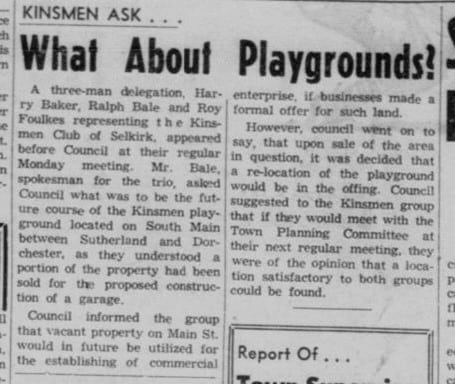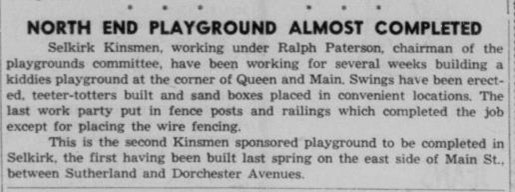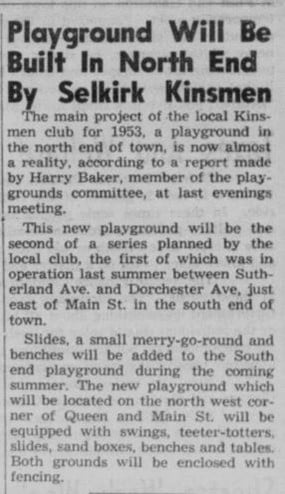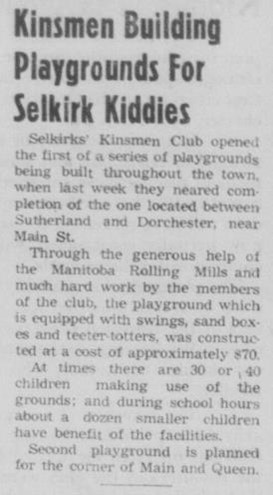301 Queen Avenue
Murray Sinclair Park was one of a pair of playgrounds built by the Kinsmen Club of Selkirk in the mid-1950s. It was part of a national Kinsmen program to provide improved play opportunities for the new wave of children born immediately after the war.
Kinsmen South Playground on Main Street at Dorchester Avenue was the first to open in the summer of 1952.
The following spring, construction got underway at Kinsmen North Playground on Main Street at Queen Avenue (present-day Murray Sinclair Park). The city-owned land was vacant and being held as a possible site for a new school, though in 1958 the school board informed the city that it no longer needed the site.
The playground was ready for use in July 1953. It included swings, a teeter totter, sand boxes and benches. The perimeter was enclosed with a wire fence.
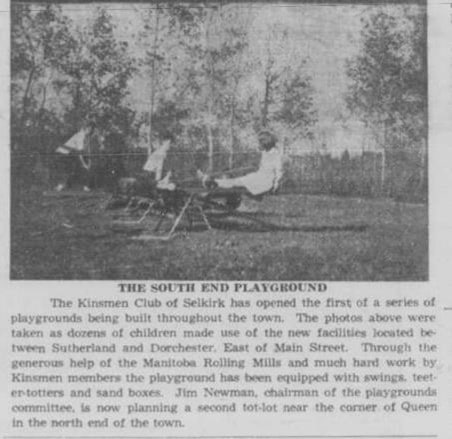
Naming The Park
For more than 50 years the playground did not have a name. The Kinsmen association disappeared in the 1970s, so residents just called it ‘the playground on Queen Avenue’. That ended in 2017 when it was named after Senator Murray Sinclair.
Also known by his Anishinaabe name, Mizanay Gheezhik (One Who Speaks of Pictures in the Sky), the Honourable Murray Sinclair has been a prominent figure in the Manitoba justice system for over 25 years. He became a household name as Chief Commissioner of the Truth and Reconciliation Commission of Canada.
A member of the Peguis First Nation, Sinclair was born in 1951, just north of Selkirk. A child of residential school survivors, Sinclair lost his mother while just an infant. He and his three siblings were raised by their grandparents. A gifted student, he skipped two grades and was only 16 when he graduated from Lord Selkirk Regional Comprehensive School as valedictorian and athlete of the year.
After two years at the University of Manitoba, Sinclair put his studies on hold to care for his ailing grandmother. While working at the Selkirk Friendship Centre, he was elected vice president of the Manitoba Métis Federation and befriended the province’s then Attorney General, Howard Pawley. Pawley inspired Sinclair to shift his studies to law and Sinclair was called to the Manitoba Bar in 1980.
With the guidance of elder Angus Merrick, of the Long Plains First Nation, and other mentors, Sinclair built a reputation balancing the western legal system with Anishinaabe traditions and teachings. He was named Manitoba’s first Indigenous judge in 1988.
Not long after this appointment, he was called to put his experience with Indigenous and human rights issues to the task of co-chair of the Aboriginal Justice Inquiry. This sweeping report listed over 300 recommendations for reforming Manitoba’s justice system and is considered a turning point for the treatment of Indigenous Peoples in Canada. Sinclair’s handling of this inquiry is one of the reasons he was sought after to lead the Truth and Reconciliation Commission.
As a member of the Senate of Canada, Sinclair continued to work to further Indigenous rights and reconciliation through advocacy, education, outreach and mentorship. On January 31, 2021 he retired from the Senate of Canada.
The City of Selkirk celebrated Sinclair’s achievements at a banquet held in his honour on June 20, 2017. It was announced that the park near where he once lived (the former Kinsmen North Playground) would be named for him. In his speech, Mayor Larry Johannson said, “Beyond just the recognition of Sinclair’s leadership, Murray Sinclair Park will serve as a constant reminder to young people who play there that they too can grow up in our community and accomplish great things”.
Honoured for Reconciliation Efforts
In 2017 The Honourable Murray Sinclair was awarded the Meritorious Service Cross (Civil Division).
The Meritorious Service Decorations celebrate Canadians who have performed an exceptional deed or activity that brings honour to Canada. Justice Murray Sinclair along with Chief Wilton Littlechild and Marie Wilson were honoured for shouldered the responsibility for the Truth and Reconciliation Commission of Canada with fortitude, compassion and perseverance. Over six years, they led the examination of the Indian Residential School system, combing through myriad documents and witnessing the courage of survivors who shared their stories. Their final report invites all Canadians to confront the inequities of the past and calls on governments and individuals alike to move forward, with greater understanding, towards reconciliation.
On December 29, 2021 The Honourable Murray Sinclair was appointed as a Companion for the Order of Canada.
A Companion of the Order of Canada recognizes outstanding achievement and merit of the highest degree, especially in service to Canada or to humanity at large. Those appointed to the Order have changed the nations measure of success and, through the sum of their accomplishments, have helped build a better Canada.
The Honourable Murray Sinclair was recognized for his commitment to the representation of Indigenous legal issues, and for his dedication to reconciliation between Indigenous and non-Indigenous Canadians.
Murray Sinclair Park Collection
Sources
Selkirk Enterprise 1952, 1953, 1956, 1958, 1978
Selkirk Journal 2017
Selkirk, Man., to honour Senator Murray Sinclair in park name – CBC, 2017
The Hon. Murray Sinclair, Senator – Library of Parliament



